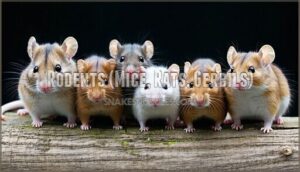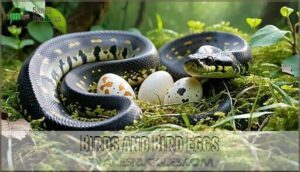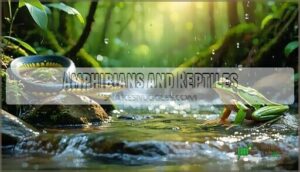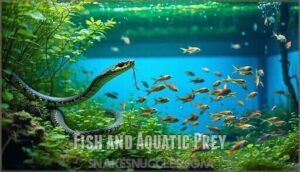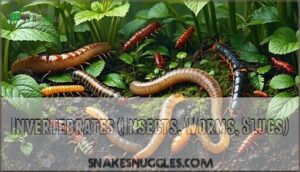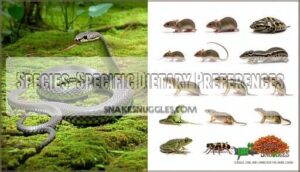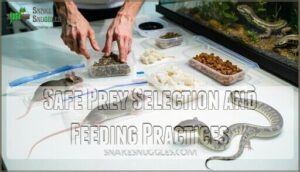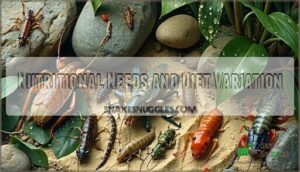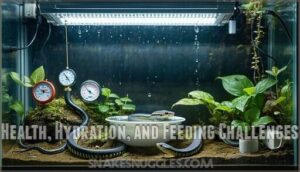This site is supported by our readers. We may earn a commission, at no cost to you, if you purchase through links.
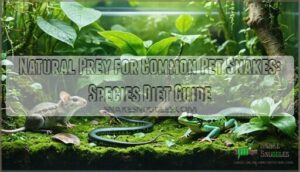
The difference between a rodent’s urgent scuttle and the quiet presence of a frog can mean everything for your snake’s health—because each species carries its own script for survival in the wild.
Understanding the natural prey for common pet snakes isn’t a matter of trivia; it’s how you tap into instincts honed over millennia. When science meets your terrarium, you foster a diet that benefits both body and behavior.
Table Of Contents
Key Takeaways
- Matching a snake’s diet to its natural prey—whether rodents, birds, amphibians, fish, or invertebrates—is key for meeting both their nutritional and behavioral needs.
- Most pet snakes thrive on frozen-thawed prey, like properly sized mice or rats, which reduces the risk of parasites, injury, and nutritional gaps compared to live or wild-caught food.
- Every snake species has its own preferred prey and unique dietary requirements, making it essential to offer whole prey and vary prey types for complete nutrition and enrichment.
- Safe feeding and hydration practices—like using reliable prey sources, maintaining clean water, and managing stress—are crucial for preventing health problems and supporting your snake’s well-being.
Natural Prey for Popular Pet Snake Species
Understanding what your snake naturally eats in the wild helps you provide the right nutrition in captivity. Different snake species have evolved to hunt specific types of prey, from small rodents to fish and insects.
Let’s look at the main prey categories that popular pet snakes consume.
Rodents (Mice, Rats, Gerbils)
Rodents—especially mice, rats, and gerbils—form the dietary backbone for most constrictor species kept in captivity, providing complete nutrition in a single, convenient package. Prey size matters: younger snakes thrive on appropriately sized mice, while adult specimens often switch to rats as their girth increases.
Frozen storage makes rodent prey readily available year-round, and ethical sourcing ensures your snake receives humanely processed food. Feeding frequency generally ranges from weekly to biweekly, depending on your snake’s age and metabolic needs.
Birds and Bird Eggs
Some snake species—including ball pythons and boa constrictors—naturally hunt birds in the wild, and while avian prey isn’t as common in captivity, it can offer valuable dietary variety for certain individuals. Quail chicks are the most practical option, though availability fluctuates with seasonal variation. Bird eggs provide concentrated nutrition but shouldn’t replace whole prey entirely.
Consider these avian prey factors:
- Wild birds carry parasites and diseases that threaten captive snakes
- Egg nutrition lacks bones and complete mineral profiles
- Bird availability through suppliers remains inconsistent year-round
- Frozen quail offers safer, more reliable supplementation than live options
Amphibians and Reptiles
While birds represent a familiar menu item for some constrictors, amphibians and reptiles occupy a less obvious but equally important niche in the diets of certain snake species—though these prey types demand extra caution in captive settings.
Garter snakes and water snakes naturally consume frogs, toads, and lizards in wild diets, but captive feeding presents challenges. Amphibians carry parasites and skin toxins, while sourcing ethical, pathogen-free reptilian prey proves difficult—making these options generally unsuitable for most captive collections.
Fish and Aquatic Prey
For aquatic and semi-aquatic species like garter snakes and water snakes, fish can form a significant portion of their natural diet—but not all fish are created equal regarding captive nutrition. Certain fish species contain thiaminase, an enzyme that destroys vitamin B1, leading to neurological deficiencies in aquatic snakes over time.
To avert thiaminase risks and guarantee proper nutrition, you should:
- Choose thiaminase-free fish like silversides, salmon, or trout
- Avoid goldfish, minnows, and carp that contain harmful enzymes
- Offer whole fish to provide balanced calcium and nutrients
- Rotate fish variety with amphibians when appropriate for species
Feeding frequency for aquatic snake diets should match their metabolism, generally every five to seven days for adults. Parasite prevention requires sourcing frozen fish as a food source rather than wild-caught specimens.
Invertebrates (Insects, Worms, Slugs)
Beneath the radar of most snake keepers, invertebrates like earthworms, slugs, and soft-bodied insects sustain several smaller snake species that rarely appear in mainstream pet trade discussions. Rough green snakes and ringneck snakes, for example, thrive on these prey items in captivity.
When sourcing invertebrates, you must consider nutritional value through insect gutloading and worm gutloading practices, ensuring prey contains adequate nutrients. Wild-collected slugs pose slug toxicity risks from pesticide exposure, making invertebrate sourcing from reliable suppliers essential for your snake’s safety.
Species-Specific Dietary Preferences
Understanding what your snake naturally eats in the wild helps you make better feeding decisions at home. Different species have evolved to hunt specific prey, and their bodies are built for it.
Let’s look at the dietary preferences of some popular pet snakes and what that means for their care.
Ball Python Prey Choices
Ball pythons, equipped with specialized infrared-sensing pits on their faces, have evolved to hunt warm-blooded prey with striking precision in the wild. Their natural diet consists primarily of small mammals and birds. Male ball pythons tend to consume a higher percentage of birds, while females favor rodents.
In captivity, appropriately sized mice and rats provide excellent nutritional balance, matching their wild prey choices. Understanding these feeding preferences helps you meet your snake’s dietary needs and maintain proper feeding frequency.
Boa Constrictor Feeding Habits
A Boa constrictor’s snake diet is shaped by both prey size and feeding environment. On Aruba, their diet includes mammals, birds, and lizards, with even large boas eating small prey. They use ambush hunting strategies and constriction, feeding less often when prey is scarce.
Boas require specific habitat conditions to thrive in captivity. Hydration needs rise with feeding, so always offer fresh water.
Garter Snake Natural Diet
Did you know garter snakes show striking Dietary Specialization shaped by Prey Availability and Geographic Variation? Young snakes favor earthworms and slugs, while larger individuals shift toward fish and amphibians—a classic example of Ontogenetic Shifts.
It’s important to remember that captive garter snakes need a diet that provides complete nutrition. In captivity, balancing their snake diet with varied prey bolsters Captive Nutrition, especially for aquatic snakes and diverse snake species.
Other Common Pet Snake Species
You’ll find corn snakes thrive on rodents, while king snakes and milk snakes add reptiles, amphibians, and bird eggs to their menu. Rat snakes focus on small mammals, and hognose snakes specialize in amphibians.
These species-specific diets highlight the importance of following reptile feeding guidelines for best snake diet and nutrition, securing healthy, balanced snake diets in captivity.
Safe Prey Selection and Feeding Practices
Choosing the right prey and feeding method is key to keeping your snake healthy and stress-free. There are several important factors to weigh before you offer any food.
Here’s what you should keep in mind as you look at your options.
Risks of Feeding Live Prey
Did you know feeding live prey can turn your snake’s next meal into a risky gamble? Injury potential and disease transmission aren’t just buzzwords—they’re real threats.
Consider these risks of live prey:
- Rodent bites can cause severe wounds.
- Stress response disrupts feeding.
- Legal ramifications exist in some countries.
- Ethical considerations demand humane treatment.
Benefits of Pre-Killed and Frozen-Thawed Prey
Switching to pre-killed or frozen-thawed prey spares your snake from the dangers of live meals, and makes feeding safer and more predictable for both you and your pet.
Humane feeding reduces injury prevention concerns, lowers parasite risk, and ensures consistent nutritional value.
Plus, prey availability and cost savings make a pre-killed diet a practical, safe food option.
Sourcing Safe and Nutritious Prey
Once you’ve settled on pre-killed prey for your snake, it’s time to figure out where to get food that’s both safe and packed with the nutrition your pet needs.
Consider prey source ethics and frozen prey quality when choosing suppliers. Prey size matters—match it to your snake’s girth.
Always prioritize safe practices and compare nutritional value across prey items.
Avoiding Harmful Prey Items
After you’ve chosen a reliable source for your snake’s meals, it’s just as important to make sure you’re steering clear of prey items that could put your pet’s health at risk.
Watch for Thiaminase Risks in fish, Live Prey Dangers like rodent bites on snakes, Parasite Transmission, Toxin Accumulation, Improper Sizing, and harmful bacteria—prioritize prey safety and safe food options.
Nutritional Needs and Diet Variation
Every snake species has its own nutritional needs and feeding patterns. Understanding these differences helps you provide the right diet and enrichment.
Here’s what you should know about their dietary variety.
Importance of Whole Prey Diets
Imagine trying to build a house with missing bricks—feeding your snake anything less than whole prey leaves gaps in their nutrition that can’t be patched.
Whole prey provides nutrient completeness, balanced nutrition, and meets all reptile nutritional needs. Without whole prey, dietary diseases may arise, making supplement necessity more likely.
Prey variety further ensures your snake’s diet remains healthy.
Nutritional Balance for Different Species
While each snake species has unique nutritional needs, achieving nutritional balance means meeting their Protein Requirements, Fat Metabolism, Bone Health, Vitamin Needs, and Hydration Levels. For example, ball pythons and boas need higher protein and calcium, while garter snakes benefit from thiaminase-free fish. Consider these factors for suitable reptile nutrition:
- Protein Requirements
- Fat Metabolism
- Bone Health
- Vitamin Needs
- Hydration Levels
When to Supplement Snake Diets
Although whole prey usually covers all nutritional bases, there are moments when adding supplements becomes essential for your snake’s health. If your snake shows signs of Specific Deficiencies—like vitamin deficiencies or bone weakness—vitamin supplementation may be needed.
Always follow Dosage Guidelines, as excessive supplementation can cause Long-Term Effects. Consult a veterinarian about Supplement Types and Health Conditions before adjusting snake diets.
Diversifying Prey for Enrichment
Whether you’re caring for a single snake or a whole collection, offering a variety of prey can stimulate natural hunting behaviors and support overall well-being.
Enrichment Feeding through diet diversification—using alternative prey items—promotes Behavioral Benefits and Hunting Simulation.
Prey Variety also helps achieve Nutritional Completeness, making prey selection for snakes a practical approach to enrichment and snake diet diversification.
Health, Hydration, and Feeding Challenges
Keeping your snake healthy means paying attention to how often it eats, its access to water, and the environment around it. Each of these factors can affect feeding habits and overall well-being.
Let’s look at the key elements you’ll need to manage in your enclosure.
Feeding Frequency and Schedule
How often your snake eats isn’t just a matter of routine—it’s a reflection of its species, age, and even the season. Feeding intervals shift with age-based schedules and seasonal adjustments; hatchlings need frequent meals, while adults thrive on longer fasting periods.
Following snake feeding guidelines helps prevent regurgitation risks and promotes healthy feeding habits. Your feeding schedule matters.
Hydration and Water Requirements
Water isn’t just a luxury for your snake—it’s as essential to their health as the right prey on their menu. Choose a water bowl size that allows soaking behavior, and keep water quality high by cleaning daily.
Humidity control matters, especially for shedding. Watch for dehydration signs; aquatic species have higher snake water requirements, so prioritize hydration for all reptiles.
Stress, Environment, and Feeding Response
Even the heartiest appetite can vanish if your snake’s surroundings feel more like a stormy sea than a calm, secure haven.
Environmental stressors—from loud noises to sudden changes—can trigger feeding refusal or anorexia.
Minimize interaction impact during the adjustment period, and observe snake behavior closely. Adjust environmental factors, improve prey item presentation, and reduce stress to support better feeding responses.
Frequently Asked Questions (FAQs)
Can snakes eat wild-caught prey from outside?
Letting your snake hunt wild-caught prey is like welcoming the unknown through your front door—Wild Prey Risks loom, from Parasite Transmission and Pesticide Exposure to Bacterial Infections.
For snake prey safety, always choose safe food sources for snakes.
How to transition a snake to new prey types?
Begin by Scent Training using familiar smells on new prey, then attempt Gradual Introduction and Size Adjustment.
Overcome Feeding Resistance with alternative food sources, patience, and close observation, identifying snake food preferences to prevent common feeding problems.
What signs indicate an allergic reaction to prey?
Watch for Prey Allergy Symptoms like sudden Skin Reaction Signs (hives, redness), labored breathing, vomiting or regurgitation, and Behavioral Changes.
Any Respiratory Distress, Digestive Issues, or unusual shedding may point to snake health concerns needing veterinary care.
Are prey size differences a choking hazard for snakes?
Imagine swallowing a whole apple—snakes face a similar risk if prey size exceeds the ideal diameter.
Oversized meals stress snake anatomy and can lead to regurgitation, poor constriction effectiveness, or choking hazard concerns in feeding.
How does prey diet affect snake coloration?
Prey diet influences snake coloration through mechanisms like Prey Carotenoids, Melanin Influence, and Lipid Deposition.
Nutritional variations, genetic factors, and environmental interaction drive shifts in color, making diet a key factor in snake appearance.
Conclusion
Patterns of predation and preference paint the puzzle of your snake’s natural world. Choosing meals that mirror the natural prey for common pet snakes fosters vitality, sharpens instincts, and satisfies both nutritional and behavioral needs.
Reliable routines, variety, and vigilance yield not just a well-fed pet, but a glimpse into evolutionary harmony. Each feeding cycle is more than a chore—it’s connection, care, and a quiet affirmation that understanding nature’s blueprint elevates everything beneath the scales.
- https://jackrellab.biosci.ucsd.edu/wp-content/uploads/2021/11/Reinert_etal_HerpConBio_2021.pdf
- https://en.wikipedia.org/wiki/Boa_constrictor
- https://www.petmd.com/reptile/boa-constrictor-care-sheet
- http://vtfishandwildlife.com/learn-more/vermont-critters/reptiles/common-garter-snake
- https://www.fs.usda.gov/psw/publications/matthews/psw_2002_matthews001.pdf

